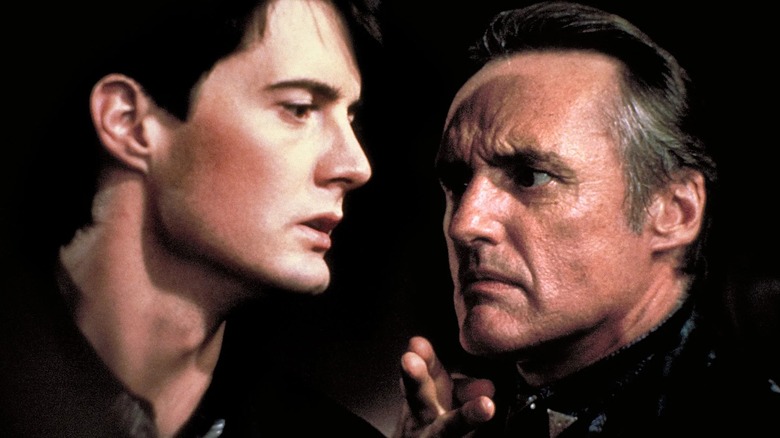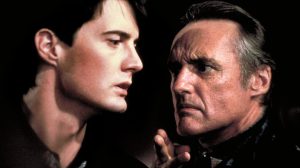Was the Well-Dressed Man’s Disguise in Blue Velvet a Hidden Clue to Frank Booth’s Identity?

The Enigmatic Disguise in Blue Velvet
David Lynch’s Blue Velvet (1986) is renowned for its layers of mystery and symbolism. One of the more subtle but striking moments in the film is the character known as the Well-Dressed Man. Although seemingly a minor figure, his presence has sparked debates about deeper meanings hidden within the film’s narrative. A particularly intriguing question is whether the Well-Dressed Man’s disguise could be a crucial clue to understanding the true nature of Frank Booth, the film’s villain.
In this article, we’ll explore the Blue Velvet well dressed man disguise theory, dissecting the clues that suggest it may point to Frank Booth’s identity. As we dive deeper into the film’s themes, characters, and Lynch’s penchant for hidden meanings, we’ll uncover why this small detail may be far more significant than it initially appears.
The Well-Dressed Man in Blue Velvet: Who Is He?

The Well-Dressed Man appears in a brief, yet memorable, scene of Blue Velvet. Dressed in a sharp suit and sporting a calm demeanor, he doesn’t immediately seem threatening. However, his polite and composed appearance contrasts sharply with the chaotic and violent undercurrent that runs through the film.
In this scene, the Well-Dressed Man is seen interacting with Jeffrey Beaumont (played by Kyle MacLachlan) and Dorothy Vallens (Isabella Rossellini), two of the film’s central characters. He plays a seemingly neutral role, yet his character’s calmness amid the surrounding tension leaves much to be interpreted.
Frank Booth’s Disguise: A Deeper Look
Frank Booth, the menacing figure played by Dennis Hopper, is undoubtedly one of Lynch’s most memorable villains. Booth is a violent, unpredictable drug lord who harbors a disturbing obsession with Dorothy. His character is chaotic, a stark contrast to the calm and composed Well-Dressed Man.
But could it be that the Well-Dressed Man is, in fact, a disguise for Frank Booth himself? On the surface, this may seem far-fetched. However, Lynch often uses subtle visual and character clues to suggest deeper connections, and the Well-Dressed Man may be a key part of this.
Clues Connecting the Well-Dressed Man to Frank Booth
There are several key details within Blue Velvet that suggest the Well-Dressed Man may indeed be a hidden clue to Frank Booth’s true identity:
1. The Duality of Appearance vs. Reality
Lynch frequently explores themes of duality and the contrast between surface appearances and the darker truths lurking beneath. Frank Booth’s extreme behavior and violent tendencies are hidden behind a well-groomed, polite exterior, much like the Well-Dressed Man. This could be a deliberate visual cue linking the two characters.
2. The Disguise as a Reflection of Power
In Lynch’s world, disguises often reflect a character’s desire for control and power. Frank Booth, throughout Blue Velvet, is shown to manipulate his surroundings with frightening precision. The Well-Dressed Man, in his seemingly innocent guise, is a symbol of this power. The disguise could be a way to observe the characters around him without revealing his true, chaotic nature.
3. The Dark Underpinnings of the Well-Dressed Man
While the Well-Dressed Man initially appears to be a harmless figure, the film’s atmosphere suggests otherwise. Blue Velvet is known for subverting the expectations of its characters, and Lynch masterfully employs this technique to keep the audience on edge. The fact that the Well-Dressed Man has a hidden agenda—perhaps even connected to Booth—fits perfectly with the film’s narrative style.
4. The Subtlety of Lynch’s Symbolism
Lynch’s films are layered with symbolism, and every detail matters. The choice to dress this character so sharply and present him as a calm observer may be a deliberate way to introduce the idea of Frank Booth’s ability to “blend in” when necessary. By doing so, Lynch amplifies the mystery and adds complexity to Booth’s character.
Analyzing the Well-Dressed Man’s Role in Blue Velvet
To fully appreciate the Well-Dressed Man’s potential role as a clue to Frank Booth’s disguise, it’s important to look at how Lynch structures his film. Blue Velvet is a film about the juxtaposition of innocence and corruption. The idyllic small-town exterior of Lumberton contrasts with the dark and violent world beneath it, much like the Well-Dressed Man’s polished appearance hides something far more sinister.
By subtly implying that the Well-Dressed Man could be Frank Booth in disguise, Lynch draws attention to the tension between public personas and private identities, a theme that runs throughout the entire film. This narrative technique suggests that Blue Velvet is more than just a crime thriller—it’s a psychological exploration of identity and deception.
Hidden Meanings in Blue Velvet: A Lynchian Interpretation
David Lynch’s films, including Blue Velvet, are known for their complex layers of meaning, where every scene and character can be read in multiple ways. The idea of Frank Booth disguising himself as the Well-Dressed Man fits into Lynch’s broader filmmaking style, where nothing is as simple as it seems.
The Well-Dressed Man’s role in Blue Velvet could be viewed as a symbolic representation of Booth’s need to control the situation and keep his violent tendencies hidden. Lynch often uses characters to embody themes of duality and the tension between good and evil. By considering the Well-Dressed Man as a clue to Frank Booth’s identity, we open up new avenues of interpretation about Booth’s psyche and motivations.
The Significance of Disguises in David Lynch Films
Lynch’s use of disguise is a recurring motif in his films. In Blue Velvet, Frank Booth’s dual nature is emblematic of the complex characters Lynch is known for creating. Booth’s ability to present himself as both a charming and terrifying figure speaks to Lynch’s exploration of the hidden darkness that exists within every person.
The Well-Dressed Man, then, becomes a crucial piece in the puzzle of Blue Velvet. His disguise is not just a costume—it’s a reflection of the themes of appearance versus reality, control, and the hidden nature of Frank Booth’s violence. By analyzing this disguise, we gain a deeper understanding of Lynch’s artistic vision and his portrayal of complex characters.
Conclusion: The Well-Dressed Man’s Role in Unveiling Frank Booth
While the Blue Velvet well-dressed man disguise may seem like a minor detail in the grand scheme of the film, it is undoubtedly an important clue to Frank Booth’s true identity. Lynch’s deliberate use of disguises, symbolism, and duality suggests that the Well-Dressed Man is more than just a character in passing—he is a mirror to Booth’s own hidden violence and chaotic nature.
As we peel back the layers of Blue Velvet, we come to realize that every detail, no matter how small, plays a role in building the tension and mystery that defines Lynch’s masterpiece. The Well-Dressed Man is yet another manifestation of Lynch’s ability to create complex, multifaceted characters, and his disguise is one of the most subtle but impactful clues in understanding Frank Booth’s dark persona.
What do you think about the Well-Dressed Man’s disguise in Blue Velvet? Do you believe it’s a clue to Frank Booth’s identity? Share your thoughts in the comments below, and don’t forget to share this article with fellow Lynch fans!
Leave a Comment